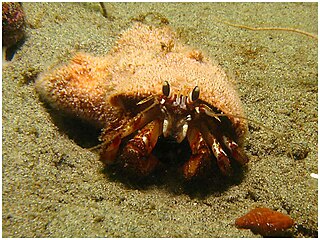
The Decapoda or decapods are an order of crustaceans within the class Malacostraca, and includes crabs, lobsters, crayfish, shrimp, and prawns. Most decapods are scavengers. The order is estimated to contain nearly 15,000 extant species in around 2,700 genera, with around 3,300 fossil species. Nearly half of these species are crabs, with the shrimp and Anomura including hermit crabs, porcelain crabs, squat lobsters making up the bulk of the remainder. The earliest fossils of the group date to the Devonian.

The Paguridae are a family of hermit crabs of the order Decapoda. The king crabs, Lithodidae, are now widely understood to be derived from deep within the Paguridae, with some authors placing their ancestors within the genus Pagurus.

Pagurus is a genus of hermit crabs in the family Paguridae. Like other hermit crabs, their abdomen is not calcified and they use snail shells as protection. These marine decapod crustaceans are omnivorous, but mostly prey on small animals and scavenge carrion. Trigonocheirus and Pagurixus used to be considered subgenera of Pagurus, but the former is nowadays included in Orthopagurus, while the latter has been separated as a distinct genus.

The Parapaguridae are a family of marine hermit crabs from deep waters. Instead of carrying empty gastropod shells like other hermit crabs, they carry colonies of dozen or more sea anemones or zoanthids. Some genera, such as Bivalvopagurus and Tylaspis, do not inhabit shells. The following genera are included:

Paguristes is a genus of hermit crab in the family Diogenidae. It includes the following species :

Munidopsis is a genus of squat lobster. It is the second largest of all the genera of squat lobsters, after Munida, with over 200 species. Its members are mainly found on continental slopes and on abyssal plains. A few fossil species are also known, including specimens from the Campanian (Cretaceous).

Munida is the largest genus of squat lobsters in the family Munididae, with over 240 species.

Eumunida is a genus of squat lobsters. The majority of its species are from the Pacific Ocean and are as follows:

Agononida is a genus of squat lobsters in the family Munididae. In 2022, recognizing that the genus as then defined was paraphyletic, it was divided into three lineages: Agononidasensu stricto and two new genera, Garymunida and Hexamunida. Agononida is distributed in the Indian and Pacific Oceans.

The family Homolidae, known as carrier crabs or porter crabs, contains 14 genera of marine crabs. They mostly live on the continental slope and continental shelf, and are rarely encountered. Members of the Homolidae have their fifth pereiopods in a sub-dorsal position, which allows them to hold objects in place over the rear half of the carapace. The objects carried include sponges, black corals and gorgonians, and this behaviour may be a defence mechanism against predators. Some species have been observed carrying living sea urchins in a symbiotic relationship which allows them to benefit from the protection of the urchin's dangerous spikes.
Porcellanopagurus edwardsi is a species of hermit crab that lives in the waters around New Zealand and its subantarctic islands.

Porcellanopagurus is a genus of hermit crabs. The genus occurs in the Pacific and Indian Oceans.
Jacques Forest was a French carcinologist.

Retropluma is a genus of heterotrematan crabs belonging to the family Retroplumidae. The extant species survive in the deep sea of the Indo-Pacific region.
Pylopaguropsis is a genus of hermit crabs containing the following species:
Paragiopagurus is a genus of hermit crabs in the family Parapaguridae, that contains 25 species. Members of this genus live at depths from 116 to 2,067 meters.

Solenocera is a genus of prawns in the family Solenoceridae. Solenocera occur from 0 to 2,067 meters deep in the ocean.
Cossuridae is a monotypic family of polychaetes belonging to the class Polychaeta. Its sole accepted genus is Cossura.
Oncopagurus africanus is a species of marine hermit crab within the family Parapaguridae. O. africanus inhabits gastropod shells often accompanied by an anthozoan polyp at depths of 235 to 555 meters below sea level. Its distribution covers the southeastern Atlantic Ocean from the Democratic Republic of the Congo to Angola, and the southwest Indian Ocean off SE of Durban.

Parapagurus is a genus of deep-sea hermit crabs in the family Parapaguridae, that contains 17 species.















